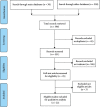Anatomical Evaluation of Root and Root Canal Morphology of Permanent Mandibular Dentition among the Saudi Arabian Population: A Systematic Review
- PMID: 35958809
- PMCID: PMC9363226
- DOI: 10.1155/2022/2400314
Anatomical Evaluation of Root and Root Canal Morphology of Permanent Mandibular Dentition among the Saudi Arabian Population: A Systematic Review
Abstract
This study aimed to conduct a compendious review of root canal morphology of "permanent mandibular teeth in different regions of Saudi Arabia" to obtain a large sample representing the total population. A detailed search through the databases Web of Science, Scopus, and PubMed was conducted following the PRISMA guidelines. The data were analyzed based on the following inclusion criteria: original full-length original articles that reported the variables of interest "(number of roots, number of canals, Vertucci's classification system and C-shaped canals or mid-mesial canals)" of the mandibular teeth and conducted on Saudi subjects. The retrieved data were presented as frequencies and percentages. The results revealed that 56.6% of mandibular central incisors had one canal and Vertucci type I (56.6%), while 57.4% of the mandibular lateral incisors had one canal, with Vertucci types I and III most frequent. In mandibular canines, 91.8% had one canal and 8.2% had two canals. Most of the mandibular first premolars had one root (86.6%), while almost all mandibular second premolars (91.5%) had one canal, and 96.9% had Vertucci type I configuration. Among the mandibular first molars, three and four canals were prevalent in 58.7% and 40.6%, respectively. The majority of mesial roots had Vertucci type IV (60.6%), and most of distal roots had Vertucci type I (72.2%). Most of the mandibular second molars had three canals (87.3%) and showed Vertucci type IV (39.4%) canals for mesial roots and Vertucci type I (95.6%) for distal roots. The C-shaped canals were seen in 8% of first premolars and 9.8% of second molars. The middle mesial canal was found in 4.2% and 0.4% of first and second molars, respectively. This review could represent "the population of Saudi Arabia as the included samples were combined from different regions of the country." Some variations were noticed within the same group of teeth from different regions. However, the overall results of combined samples were comparable to the other international studies.
Copyright © 2022 Mohammed Mashyakhy et al.
Conflict of interest statement
The authors declare that they have no conflicts of interest.
Figures
Similar articles
-
Anatomical Evaluation of Root and Root Canal Configuration of Permanent Maxillary Dentition in the Population of the Kingdom of Saudi Arabia.Biomed Res Int. 2022 Jan 15;2022:3428229. doi: 10.1155/2022/3428229. eCollection 2022. Biomed Res Int. 2022. PMID: 35075425 Free PMC article.
-
Analysis of morphology and symmetry of the root canal system of incisors, premolars and mandibular molars using CBCT.Acta Odontol Latinoam. 2024 Apr;37(1):25-33. doi: 10.54589/aol.37/1/25. Acta Odontol Latinoam. 2024. PMID: 38920123 Free PMC article.
-
Root anatomy and canal configuration of the permanent mandibular first molar: a systematic review.J Endod. 2010 Dec;36(12):1919-31. doi: 10.1016/j.joen.2010.08.055. Epub 2010 Oct 16. J Endod. 2010. PMID: 21092807
-
Variations in root canal morphology of permanent incisors and canines among Asian population: A systematic review and meta-analysis.J Oral Biosci. 2021 Dec;63(4):337-350. doi: 10.1016/j.job.2021.09.004. Epub 2021 Sep 20. J Oral Biosci. 2021. PMID: 34547454
-
Comparative study of Vertucci's and Ahmed's classifications to evaluate the root canal configuration of mandibular incisors in Saudi Arabian subpopulation.Pak J Med Sci. 2025 Jun;41(6):1658-1663. doi: 10.12669/pjms.41.6.11972. Pak J Med Sci. 2025. PMID: 40621519 Free PMC article.
Cited by
-
Three-dimensional evaluation of root canal morphology in mandibular premolars of Saudi individuals: a CBCT study.Libyan J Med. 2025 Dec;20(1):2464292. doi: 10.1080/19932820.2025.2464292. Epub 2025 Feb 8. Libyan J Med. 2025. PMID: 39921485 Free PMC article.
-
Root and canal morphology of mandibular second molars in a Chinese Kazakh population by cone-beam computed tomography.BMC Oral Health. 2025 Aug 21;25(1):1347. doi: 10.1186/s12903-025-06727-3. BMC Oral Health. 2025. PMID: 40841646 Free PMC article.
-
CBCT based investigation of frequency of Middle Mesial Canal in Mandibular First Molars of Saudi Sub-population.Pak J Med Sci. 2024 Aug;40(7):1372-1377. doi: 10.12669/pjms.40.7.9101. Pak J Med Sci. 2024. PMID: 39092036 Free PMC article.
-
Obturation quality of bioceramic sealers with different obturation techniques: a micro-CT evaluation.Sci Rep. 2024 Dec 28;14(1):31146. doi: 10.1038/s41598-024-82481-w. Sci Rep. 2024. PMID: 39732759 Free PMC article.
-
Retrospective study of the morphology of third maxillary molars among the population of Lower Silesia based on analysis of cone beam computed tomography.PLoS One. 2024 Feb 23;19(2):e0299123. doi: 10.1371/journal.pone.0299123. eCollection 2024. PLoS One. 2024. PMID: 38394283 Free PMC article.
References
-
- Mashyakhy M., Chourasia H. R., Jabali A., Almutairi A., Gambarini G. Analysis of fused rooted maxillary first and second molars with merged and C-shaped canal configurations: prevalence, characteristics, and correlations in a Saudi Arabian population. Journal of Endodontia . 2019;45(10):1209–1218. doi: 10.1016/j.joen.2019.06.009. - DOI - PubMed
-
- Mashyakhy M. H., Chourasia H. R., Jabali A. H., et al. C-shaped canal configuration in mandibular premolars and molars: prevalence, correlation, and differences: an in vivo study using cone-beam computed tomography. Nigerian Journal of Clinical Practice . 2020;23(2):232–239. doi: 10.4103/njcp.njcp_335_19. - DOI - PubMed
-
- Margarit R., Andrei O. C. Anatomical variations of mandibular first molar and their implications in endodontic treatment. Romanian Journal of Morphology and Embryology . 2011;52(4):1389–1392. - PubMed
Publication types
MeSH terms
LinkOut - more resources
Full Text Sources


